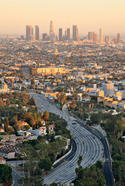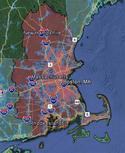Urban risk may be understood as a function of hazard, exposure, and vulnerability.1 In metro New Orleans, Katrina-like storm surges constitute the premier hazard (threat); the exposure variable entails human occupancy of hazard-prone spaces; and vulnerability implies the ability to respond resiliently and adaptively—which itself is a function of education, income, age, social capital, and other factors—after having been exposed to the hazard. read more »
Urban Issues
Special Report: The Laissez Faire New Orleans Rebuilding Strategy Was Exactly That
- Login to post comments
LA’s Tale of Two Cities
It’s the best of times and the worst of times in Los Angeles.
Los Angeles is now attracting notice as a so-called “global city,” one of the world’s elite metropolises. It is ranked #6 in the world by AT Kearney and tied for 10th in a report by the Singapore Civil Service College that I contributed to. Yet it also has among the highest big city poverty rates in the nation, and was found to be one of the worst places in America for upward mobility among the poor. Newspaper columns are starting to refer to LA as a “third world city.” read more »
The Cities Creating The Most White-Collar Jobs
In our modern economy, the biggest wellspring of new jobs isn’t the information sector, as hype might lead some to think, but the somewhat nebulous category of business services. Over the past decade, business services has emerged as easily the largest high-wage sector in the United States, employing 19.1 million people. These are the white-collar jobs that most people believe offer a ladder into the middle class. read more »
- Login to post comments
Chicago’s Great Financial Fire
My latest piece is online in City Journal and is called “Chicago’s Financial Fire.” It’s a look at the ongoing financial crisis in that city, which has all of a sudden gotten very real thanks to a downgrade of the city’s credit rating to junk by Moody’s. Here’s an excerpt: read more »
- Login to post comments
The Evolving Urban Form: Sprawling Boston
Few terms are more misunderstood than "urban sprawl." Generally, it refers to the spatial expansion (dispersion) of cities and has been use to describe urbanization from the most dense (least sprawling) in the world (Dhaka, Bangladesh), the most dense in the United States (Los Angeles) and also the least dense in the world (such as Atlanta and Charlotte, read more »
- Login to post comments
Revisiting Two Forces of Modern Urban Transformation
Few factors have had a greater impact on recent urban growth than communications technology (ICT) and property investment strategies. The evolution of both is transforming space and social interaction at an unprecedented pace and depth, with mixed results. As these maturing forces are increasingly taken for granted, the next generation of urban growth should accommodate them in ways that preserve urban vitality and citizen livelihoods.
The jetpack that wasn’t read more »
- Login to post comments
Gates and Borders, Malls and Moats: A Photo Essay of Manila
Home-made housing (left): Refugee families from Mindanao set up shop-houses in the grounds of the mosque in Quiapo. Quiapo contains a number of significant sacred sites for Catholic pilgrimages and festivals. Islamic refugees are making a living in the markets, even as some have sought refuge inside their own sacred site. read more »
- Login to post comments
Countering Progressives' Assault on Suburbia
The next culture war will not be about issues like gay marriage or abortion, but about something more fundamental: how Americans choose to live. In the crosshairs now will not be just recalcitrant Christians or crazed billionaire racists, but the vast majority of Americans who either live in suburban-style housing or aspire to do so in the future. Roughly four in five home buyers prefer a single-family home, but much of the political class increasingly wants them to live differently. read more »
How To Justify Spending $8M On Something Nobody Wants
The Minneapolis-St. Paul Metropolitan Council is gambling $8.7 million on a project to alleviate pedestrian congestion that might exist in 5 to 10 years if we’re somehow able to build two additional light rail lines and they are operating at full capacity for 10 days a year.
That’s like buying flood insurance on the house you have yet to buy. read more »
- Login to post comments
Identifying Black Urbanists
There are black urbanists. There are African-Americans who have invested their life's work toward the betterment of cities. They haven't always gotten the exposure and acknowledgement that others have received, but they have nonetheless contributed to an improved understanding of how cities work, especially in an African-American context. read more »
- Login to post comments






















